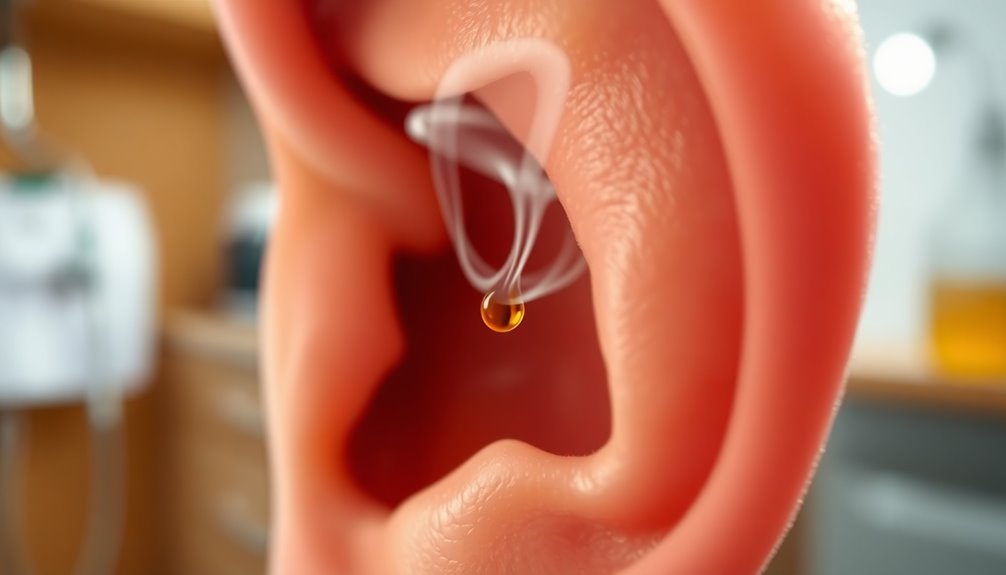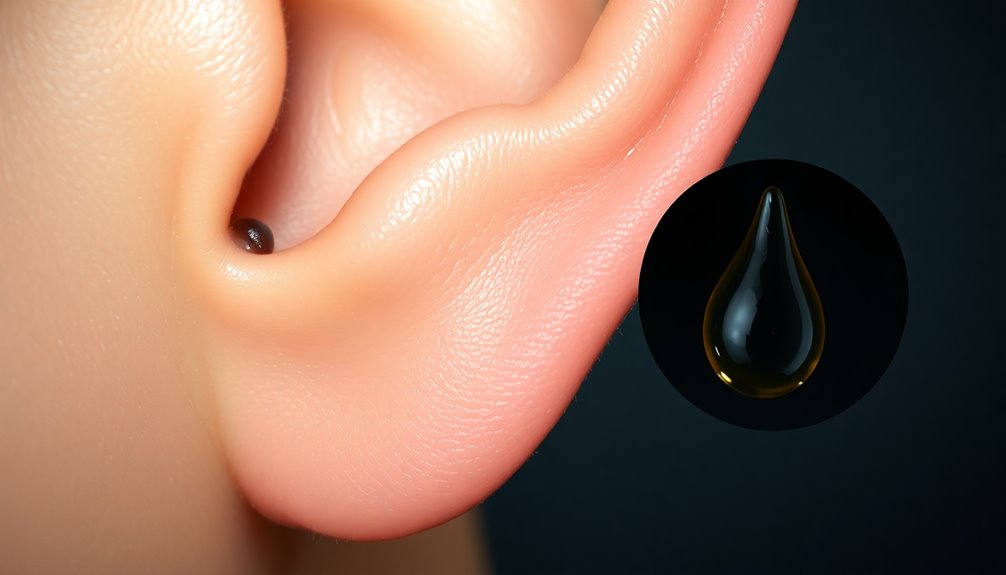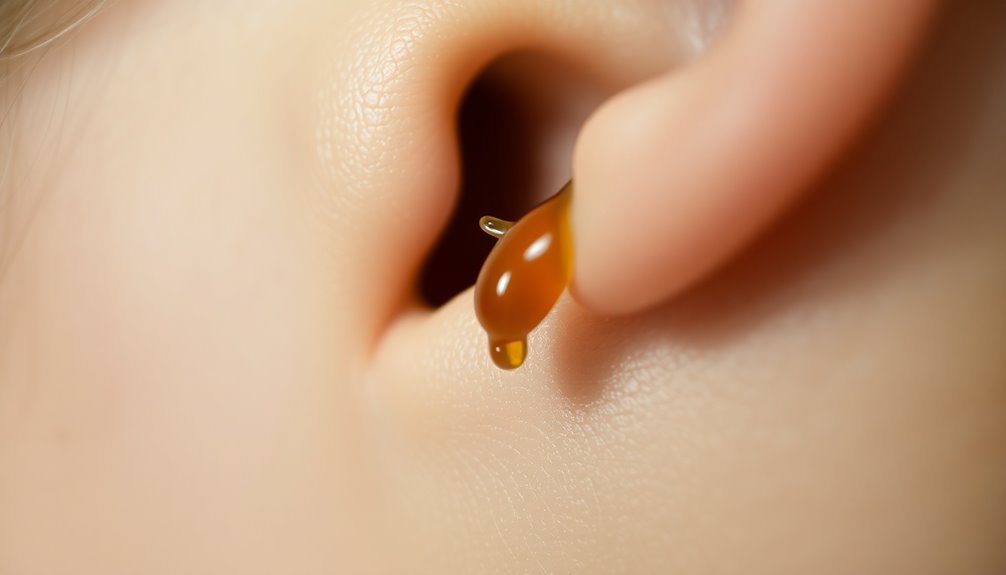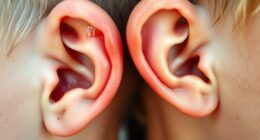Sound therapy helps relieve tinnitus by masking or reducing the perception of intrusive sounds through calming noises like white noise, nature sounds, or gentle music. It trains your brain to ignore the ringing or buzzing over time, promoting relaxation and reducing stress. You can choose from various sound types and incorporate them into your daily routine for better relief. Keep exploring options, and you’ll discover more ways to make sound therapy work for you.
Key Takeaways
- Sound therapy uses calming sounds like white noise or nature sounds to mask tinnitus and promote relaxation.
- Personalization and consistent use enhance the effectiveness of sound therapy for tinnitus relief.
- Devices such as white noise machines, hearing aids, and smartphone apps facilitate easy integration into daily routines.
- Combining sound therapy with other treatments can improve long-term relief and help retrain brain responses.
- Advancements include personalized algorithms and wearable devices for adaptive, real-time tinnitus management.
Understanding How Sound Therapy Alleviates Tinnitus

Sound therapy works by masking or reducing the perception of tinnitus sounds, helping your brain to reframe or ignore the ringing or buzzing. When you listen to calming sounds or white noise, it competes with the tinnitus, making the internal noise less noticeable. This shift allows your brain to focus less on the intrusive sounds and more on the external environment. Over time, your brain can learn to ignore the tinnitus signals, decreasing their impact. Sound therapy also promotes relaxation, which can reduce stress and anxiety associated with tinnitus. By consistently engaging with these sounds, you help retrain your brain’s response, easing the perception of tinnitus and improving your overall comfort. Understanding how sound therapy functions can help you better appreciate its benefits. This approach supports your journey toward managing tinnitus more effectively.
Different Types of Sound Therapy Techniques

There are several effective sound therapy techniques designed to help manage tinnitus, each tailored to different preferences and needs. You might find some methods more suitable than others, depending on your lifestyle and comfort level. Here are four common techniques:
- White Noise – Produces a steady, neutral sound that masks tinnitus and helps distract your mind.
- Nature Sounds – Includes rain, waves, or forest sounds to create a calming environment.
- Music Therapy – Uses soft, melodic music or customized sound playlists to reduce tinnitus awareness.
- Fractal or Pink Noise – Offers more natural, less harsh sound patterns that blend into your environment smoothly.
Experimenting with these options can help you determine which technique provides the most relief. Additionally, commercial grade heat pumps are increasingly used in healthcare facilities to maintain strict temperature regulation, which can contribute to a more comfortable healing environment.
Choosing the Right Sound Therapy Method for You

Choosing the right sound therapy method depends on your preferences and lifestyle. You’ll want to contemplate different types of sound devices and how they can be personalized to suit your needs. By exploring these options, you can find a solution that feels comfortable and effective for you. For example, some individuals find customizable soundscapes or adjustable volume settings helpful in creating a soothing environment tailored to their tinnitus relief.
Types of Sound Devices
Selecting the right sound device can considerably impact your tinnitus relief, as different methods cater to various preferences and severity levels. Here are four common types:
- White Noise Machines: Produce consistent, static-like sounds that mask tinnitus, ideal for sleep or focus.
- Fan or Nature Sound Devices: Replicate natural sounds like rain or ocean waves, creating a calming environment.
- Hearing Aids with Sound Therapy: Enhance hearing while delivering tailored sounds to reduce tinnitus perception.
- Portable Sound Generators: Small devices you carry with you, providing customizable sounds on the go.
Each device offers unique benefits, so consider your lifestyle, environment, and comfort level to find the best fit for your tinnitus management. Incorporating sound therapy into your daily routine can improve your overall quality of life.
Personalization Options
Finding the right sound therapy method depends on your personal preferences, lifestyle, and the severity of your tinnitus. You might prefer calming nature sounds or white noise, depending on what feels most soothing. Some options allow you to customize the pitch, volume, or even combine different sounds to better suit your needs. If you’re active during the day, portable devices or smartphone apps provide flexibility, while others may benefit from customized hearing aids with embedded sound generators. Consider how much time you can dedicate to therapy and whether you want a discreet, discreet option or something more noticeable. Trying different settings and seeking guidance from a tinnitus specialist can help you identify the most effective, personalized approach for relief. Additionally, understanding ethical hacking can help you identify vulnerabilities in your digital devices, ensuring your therapy tools are secure and protected from cyber threats.
How to Incorporate Sound Therapy Into Daily Life

Incorporating sound therapy into your daily routine can be straightforward and manageable with some simple adjustments. Start by setting specific times during your day to listen to your chosen sounds, like during work, relaxation, or sleep. Consistency is key to seeing benefits. Here are some ways to integrate sound therapy effectively:
- Use a portable device or app to listen during commutes or breaks.
- Schedule short sessions throughout the day to keep your auditory environment consistent.
- Play background sounds while relaxing or working to mask tinnitus.
- Incorporate sound therapy into your bedtime routine to improve sleep quality.
- Exploring best anime movies that include calming and soothing soundtracks can enhance your relaxation experience.
The Benefits and Limitations of Sound Therapy

Sound therapy offers a promising approach to managing tinnitus, providing relief for many people by masking or reducing the perception of ringing and buzzing sounds. It can help you shift your focus away from the noise, improving your quality of life. However, it’s not a cure and may not work equally well for everyone. Some individuals find limited benefit or need to try different sounds or devices to see progress. Additionally, sound therapy requires consistent use over time, which can be challenging to maintain. It’s important to set realistic expectations and understand that results vary. While it can be a valuable part of your tinnitus management, combining sound therapy with other treatments often yields the best outcomes. Recognizing the importance of guidance from healthcare professionals can enhance your experience and effectiveness with sound therapy.
Tips for Enhancing the Effectiveness of Sound Therapy

To get the most out of sound therapy, you need to establish a consistent listening routine. Incorporating background sounds can also help mask tinnitus and improve your overall comfort. Additionally, understanding cookie categories can help you manage your online privacy preferences while browsing health-related content. By sticking to these tips, you’ll enhance the therapy’s effectiveness and find more relief.
Consistent Listening Routine
Establishing a consistent listening routine is key to maximizing the benefits of sound therapy for tinnitus relief. When you stick to a regular schedule, your brain adapts more effectively, reducing the perception of ringing. To improve your routine, consider these tips:
- Set specific times each day to listen, such as morning and evening.
- Use a comfortable volume that masks tinnitus without causing discomfort.
- Keep sessions consistent in length, ideally 30 minutes to an hour.
- Track your progress to identify what times and sounds work best for you.
- Incorporate sound quality considerations to ensure clarity and effectiveness during sessions.
Consistency helps your brain form new associations, making relief more sustainable. Regular practice ensures sound therapy becomes a natural part of your daily routine, boosting its effectiveness.
Use of Background Sounds
Incorporating background sounds into your therapy sessions can markedly enhance tinnitus relief, especially when chosen carefully. Use calming, neutral sounds like white noise, nature sounds, or soft music to mask or distract from the ringing. Experiment with different types to find what’s most effective for you. Keep the volume at a comfortable level—loud enough to cover the tinnitus but not so loud that it becomes distracting. Consistency is key; play these sounds during your regular therapy sessions and at times when tinnitus bothers you most. You can use dedicated sound machines, smartphone apps, or even ambient tracks on streaming platforms. Properly selected background sounds can create a soothing environment, making your sound therapy more effective and helping your brain reframe the tinnitus. Additionally, maintaining a productive lifestyle can support overall mental well-being and enhance your therapy outcomes.
Future Directions in Tinnitus Sound Treatment
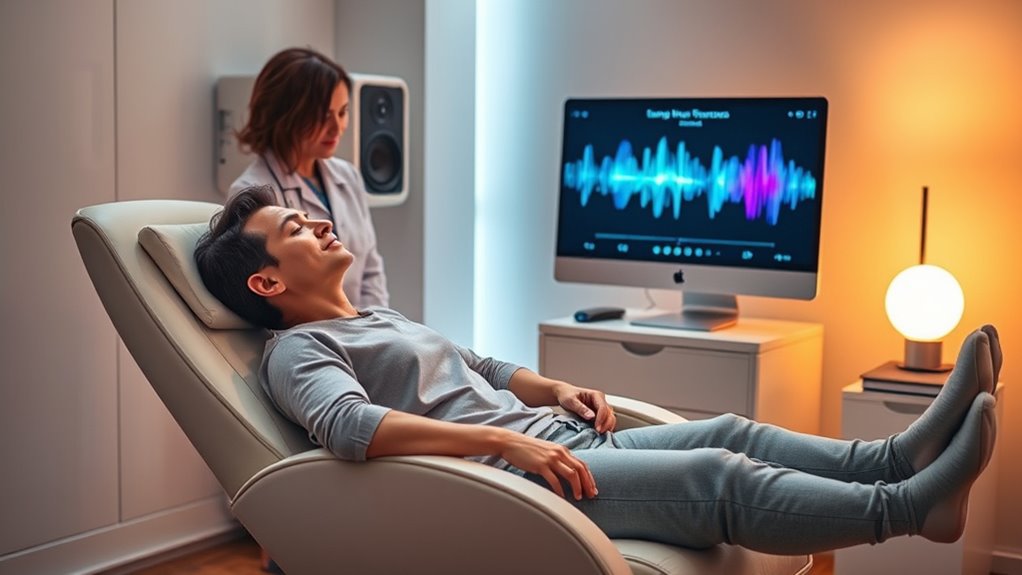
Advancements in technology and a deeper understanding of tinnitus mechanisms are shaping promising new directions for sound therapy. You can expect innovative approaches that customize treatments for your specific needs. Researchers are exploring ways to combine sound therapy with other modalities, such as neurofeedback and cognitive behavioral therapy, for enhanced relief. Additionally, new devices are being developed that deliver more precise sound stimulation, targeting the affected neural pathways more effectively.
- Personalized sound algorithms based on your tinnitus profile
- Integration of artificial intelligence for adaptive therapy
- Use of virtual reality environments to distract and retrain the brain
- Development of wearable devices for continuous, real-time treatment
Frequently Asked Questions
Can Sound Therapy Completely Cure Tinnitus?
You might wonder if there’s a complete cure for tinnitus. While sound therapy can considerably reduce your symptoms and help you manage the ringing or buzzing, it doesn’t typically eliminate tinnitus entirely. Instead, it works by masking sounds and retraining your brain to perceive less distress. So, although it can improve your quality of life, full eradication isn’t guaranteed. It’s a helpful tool, but results vary for each person.
Are There Any Risks Associated With Sound Therapy?
The risks linked to sound therapy are surprisingly mild, but ignoring them could lead to bigger problems. While it’s generally safe, some people might experience temporary discomfort, increased tinnitus awareness, or difficulty sleeping if sounds are too loud or poorly chosen. You should always consult a professional to tailor the therapy to your needs and avoid potential setbacks. Proper guidance guarantees sound therapy works effectively without risking your well-being.
How Long Does It Typically Take to See Improvement?
You might wonder how long it takes to notice benefits from sound therapy. Usually, you’ll see improvements within a few weeks to a few months, but it varies based on your condition and consistency. It’s important to stick with your routine, as regular use enhances results. Keep in mind, some people experience quicker relief, while others need more time. Patience and persistence are key to achieving the best outcome.
Is Sound Therapy Suitable for Children With Tinnitus?
Wondering whether sound therapy suits children with tinnitus? You should consider consulting a healthcare professional to explore safe, suitable solutions. While sound therapy can be tailored for younger ears, kids may respond differently than adults. It’s important to make certain that the therapy is gentle, engaging, and age-appropriate. With proper guidance, sound therapy can potentially soothe young tinnitus sufferers, supporting their comfort and concentration while they navigate their unique auditory adventures.
Can Sound Therapy Be Combined With Medication?
You can definitely combine sound therapy with medication to manage tinnitus effectively. Many healthcare providers recommend using both approaches together, as medication can help reduce the severity of symptoms, while sound therapy distracts your brain from the ringing. Always consult your healthcare professional before starting or adjusting treatments. Combining these methods often provides better relief, helping you better cope with tinnitus and improve your overall quality of life.
Conclusion
By exploring sound therapy, you hold a powerful tool to quiet the noise in your mind. Think of it as turning down the volume on tinnitus, allowing your inner peace to shine through. With the right technique and a bit of patience, you can transform your daily life into a calmer, more harmonious symphony. Keep experimenting and stay hopeful—you’re tuning your way toward relief, one sound at a time.



